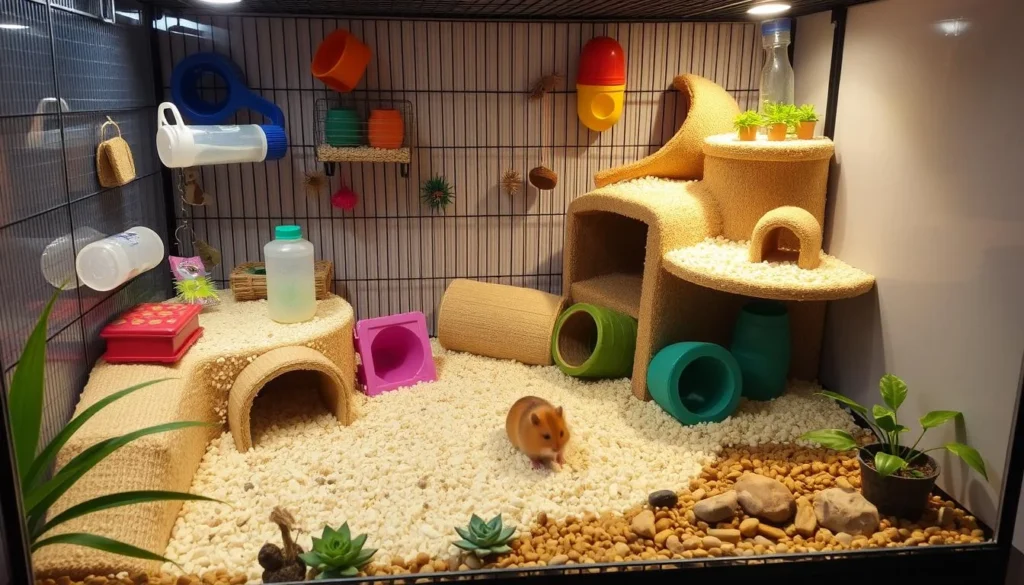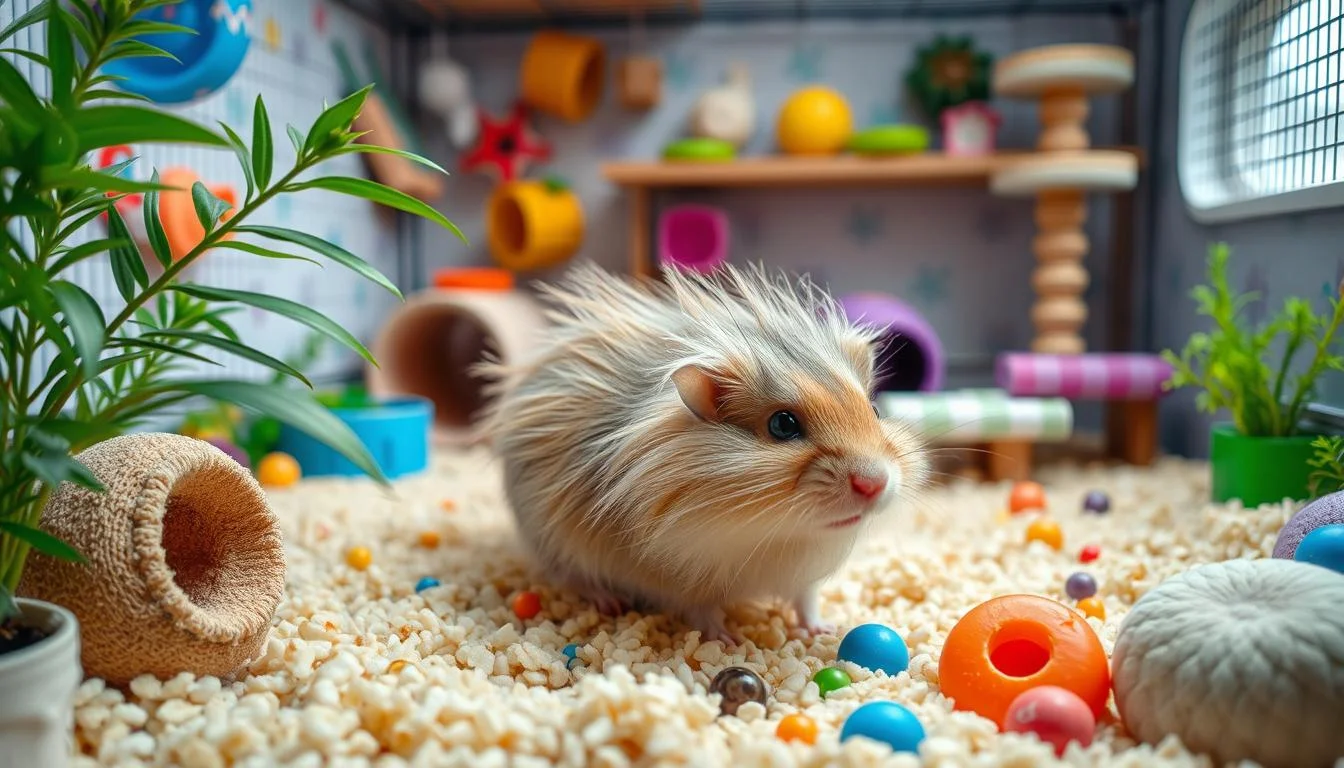Table of Contents
Imagine bringing home a fuzzy ball of joy that fits in the palm of your hand – that’s the magic of a long haired hamster. These tiny creatures capture hearts with their adorable fluffy coats and playful personalities. Unlike typical pets, long haired hamsters require specialized care that goes beyond simple feeding and housing.
As a small nocturnal animal weighing between 30 to 150 grams, your long haired hamster needs dedicated attention. Specialists caution that these delicate pets aren’t suitable for young children who might not understand their unique needs. With the right knowledge, you can create a loving home for these remarkable little companions.
This guide will walk you through everything you need to know about long haired hamster care. We’ll cover understanding their specific requirements, providing optimal nutrition, and creating a comfortable living environment.
Key Takeaways
- Long haired hamsters are delicate pets requiring specialized care
- These animals have unique nutritional and housing requirements
- Proper handling and understanding of hamster behavior is key
- Regular veterinary check-ups are essential for their health
- Creating a safe, comfortable environment is key to hamster happiness
Understanding Long Haired Hamster Breeds
Exploring hamster breeds reveals a world of cute companions. Syrian and teddy bear hamsters are favorites among pet lovers. They are known for their long hair.

Syrian vs Teddy Bear Hamsters: Key Differences
Teddy bear hamsters are a special type of Syrian hamster. They have extra fluffy coats. Here are some main differences:
- Size: Syrian hamsters are 4-7 inches long
- Weight: They weigh about 120 grams (4 ounces)
- Coat: Teddy bear hamsters have very long, soft fur
- Temperament: They are often slower and friendlier
Common Physical Characteristics
Syrian hamsters are known for their strong build and many coat colors. The teddy bear version is special for its soft, long fur. This fur needs extra care.
“Syrian hamsters are recommended as ideal first pets due to their larger size and friendly personality.” – Hamster Care Experts
Unique Personality Traits
Each hamster breed has its own traits. Syrian hamsters like to be alone. They are also calmer and move slower than smaller hamsters.
Choosing a Syrian or teddy bear hamster brings joy and fun. These pets are great for those who love rodents.
Essential Housing Requirements for Your Furry Friend
Creating the perfect home for your fancy hamster is key for their health and happiness. A well-designed habitat keeps your furry friend comfortable, safe, and entertained.

Selecting the Right Cage
Choosing the right cage is vital for hamster care. Your hamster needs enough space to explore and play. Experts say Syrian hamsters need at least 360 square inches of floor space.
- Choose cages with solid, smooth surfaces
- Ensure bar spacing is less than ½ inch to prevent escapes
- Select materials like glass or sturdy plastic terrariums
Bedding Considerations
Deep, comfortable bedding is key for your fancy hamster’s natural burrowing. Pick bedding that’s both comfy and safe.
- Use paper-based or aspen wood shavings
- Aim for 4-6 inches of bedding depth
- Avoid cedar or pine shavings, which can be toxic
Temperature and Ventilation Needs
Keeping the right environment is vital for your hamster’s health. Keep their habitat away from direct sunlight and drafts.
Ideal temperature range: 65-75°F with moderate humidity
Good ventilation stops moisture buildup and keeps your hamster healthy. Clean the cage weekly and spot-clean daily to keep it fresh.
Special Grooming Needs for Long Haired Hamsters
Long-haired hamsters need special care for their grooming. They must be groomed regularly to keep their fur healthy and untangled. This is key to their health and happiness.
These hamsters have long, beautiful coats that need extra attention. Grooming them once a week helps avoid fur matting. Without regular grooming, up to 30% of long-haired hamsters may get fur mats.
Essential Grooming Tools and Techniques
- Use a soft-bristled, small pet brush designed for gentle fur care
- Invest in a fine-toothed comb specially for hamsters
- Prepare a sand bath with chinchilla sand for natural cleaning
“Gentle grooming is the key to maintaining your long-haired hamster’s beautiful coat and overall health.”
Sand baths are vital for hamster grooming. Chinchilla sand removes oils and keeps fur clean. Owners spend about 1 hour a week grooming, keeping their pets in great shape.
Grooming Best Practices
- Brush gently in the direction of fur growth
- Check for any skin irritations or unusual lumps during grooming
- Trim long fur carefully if it becomes excessively tangled
- Reward your hamster with a small treat after grooming sessions
Grooming your hamster regularly keeps them looking good and helps you bond. With the right approach, your long-haired hamster will stay clean, comfortable, and joyful.
Creating the Perfect Diet Plan
Making a balanced diet for your hamster is key to their health and long life. Your long-haired hamster needs a diet that’s full of nutrients. This keeps them happy and full of energy.
Daily Nutritional Requirements
A good hamster diet should follow these main rules:
- 75% pellets and seeds
- 20% fresh foods
- 5% treats
Fresh Food Options and Portions
Adding fresh foods to your hamster’s diet is important. Choose a variety and keep portions small. Good choices include:
- Kale
- Carrots
- Broccoli
- Berries
Here’s what to give them daily:
- Pelleted food: A few tablespoons
- Loose seed mix: About 1/8-cup
- Fresh vegetables: Small, bite-sized pieces
Safe Treats and Supplements
Give treats sparingly in your hamster’s diet. Follow these tips:
- Nuts: 1-2 small nuts once per week
- Whole grains: Small bits of whole-grain toast or cereals
- Avoid sugary and citrus options
“A balanced diet is the foundation of a healthy, happy hamster.”
Remember, your hamster can only survive 3-4 days without food, so consistent, nutritious meals are essential for their well-being.
Exercise and Enrichment Activities
Understanding hamster behavior is key to keeping your pet happy and healthy. Long-haired hamsters need more than just a wheel for exercise.
Hamsters are naturally active and need daily physical and mental challenges. A well-designed habitat turns your pet’s home into a fun playground. It meets their instinctive behaviors.
Essential Exercise Equipment
- Running wheel with solid surface (prevents injury)
- Tunnels for exploration
- Climbing structures
- Foraging toys
Choose exercise gear that fits your long-haired hamster’s needs. A wheel between 8-12 inches is best for Syrian breeds. It gives them enough room to run comfortably.
Mental Stimulation Techniques
- Rotate toys weekly to prevent boredom
- Create maze-like environments
- Hide treats for natural foraging behavior
- Provide chew toys for dental health
“A stimulated hamster is a happy hamster”
Make sure to give your hamster 1-2 hours of playtime outside the cage each week. This keeps them fit and strengthens your bond.
Every hamster is different, so watch what they like and change things up. The goal is to create a safe, engaging space that feels like their natural home.
Health Monitoring and Common Issues
It’s important to know about your hamster’s health to keep them happy and healthy for a long time. These small pets can face many health problems. It’s key to watch them closely and act fast if needed.
Watching your hamster every day can help spot health issues early. How quickly you notice and deal with these problems can greatly affect their lifespan.
Signs of Illness to Watch For
- Sudden weight loss or changes in eating habits
- Lethargy or decreased activity levels
- Unusual discharge from eyes or nose
- Changes in fur quality or excessive hair loss
- Diarrhea or wet tail symptoms
Preventive Care Measures
Keeping their home clean and feeding them right are important for a long life. Regular health checks can stop many common problems.
- Clean the cage weekly
- Provide fresh water daily
- Monitor diet and nutrition
- Check for any physical changes
- Maintain consistent temperature
When to Visit the Vet
Some health issues need a vet right away. If you see any of these signs, get a vet appointment:
“Early detection can make a significant difference in your hamster’s health and lifespan.”
- Persistent diarrhea
- Respiratory difficulties
- Significant behavioral changes
- Visible lumps or skin issues
- Signs of extreme stress
Remember, proactive care is the best way to support your hamster’s health and potentially extend their lifespan.
Building Trust and Handling Techniques
Understanding hamster behavior is key to bonding with them. These small creatures have unique personalities. They need gentle, patient interactions to trust you.
When you approach your hamster, they are naturally cautious. Experts say start with short, managed handling sessions. This respects their comfort zone.
“Patience is key when building a relationship with a hamster. Their trust is earned, not given instantly.”
- Begin handling when hamsters are between 3-4 weeks old for best results
- Limit training sessions to 10 minutes to match their attention span
- Use positive reinforcement techniques
- Avoid sudden movements or loud noises
To manage hamster behavior, use these handling techniques:
- Always wash hands before handling to remove unfamiliar scents
- Let your hamster approach you voluntarily
- Speak softly and move slowly
- Offer small treats to create positive associations
Experts say consistent, gentle interactions make hamsters more comfortable with humans. It takes a few days to a week for them to adjust. Be patient and keep trying.
Remember, each hamster is unique. Some will warm up quickly, while others might take more time to feel secure.
Setting Up a Daily Care Routine
Creating a daily care routine is vital for your hamster’s health and happiness. Hamsters love routine and need careful attention to their needs. Knowing their lifestyle helps you make a care schedule that keeps them happy and healthy.
Morning Care Tasks
Your morning routine should be gentle and quick. Hamsters sleep during the day because they are nocturnal. Here are the important tasks:
- Check water bottle and replace if empty
- Quickly spot-clean any soiled bedding areas
- Ensure food dish has sufficient fresh food
- Observe your hamster’s overall appearance and behavior
Evening Care Tasks
The evening is the best time for hamster care and play. Between 8:00 – 10:00 p.m., they are most active and enjoy interaction:
- Provide fresh evening meal
- Clean food and water containers
- Offer supervised playtime
- Check for any signs of health issues
Weekly Maintenance Schedule
A weekly care routine is key to keeping your hamster healthy and their cage clean:
- Deep clean entire cage
- Replace all bedding (recommended depth: 2-3 inches)
- Inspect and clean wheel and toys
- Rotate enrichment items to prevent boredom
Monthly Health Checks
Regular health checks are vital in hamster care. A thorough monthly check can catch health issues early:
- Weigh your hamster
- Check teeth and nails
- Examine skin and coat condition
- Look for any lumps or unusual changes
Pro tip: Consistency is key in hamster care. A structured routine helps your pet feel secure and allows you to quickly identify any health concerns.
Conclusion
Caring for a long haired hamster is a rewarding journey. It requires dedication, understanding, and love. These furry friends bring unique challenges and immense happiness to pet owners.
By following the insights in this guide, you’ll know how to care for your long haired hamster. Syrian hamsters, the most common breed, offer an incredible pet experience. They need proper attention, a perfect habitat, and understanding of their nutritional needs.
The pet industry values the bond between humans and their small animal companions. Your long haired hamster is more than a pet; they’re a family member. Each hamster has a unique personality, so taking the time to understand their needs is key.
Stay committed to providing a nurturing environment and regular health checks for your hamster. With the right knowledge and approach, your furry friend will enjoy a happy, healthy life by your side.
